Once upon a time, Chevy’s Blazer was a full-size 4×4 – this was before there were “SUVs” – and it came standard with a V8 engine. It has since gotten smaller – and it’s now a crossover.
Similar to so many others.
But it does still offer a V6 – and that’s something that’s becoming hard to find in a new crossover. 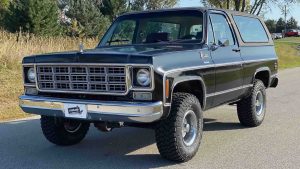
And – so equipped – it can pull more (4,500 lbs.) than most crossovers. Many of which are four cylinder-only crossovers.
What It Is
The Blazer is a mid-sized (and mid-priced) crossover with two rows of seats, five-passenger capacity and an available V6.
Base price is $34,800 for the front-wheel-drive (and four cylinder-powered) 2LT trim, which can be optioned with all-wheel-drive. This version of the Blazer stickers for $37,500.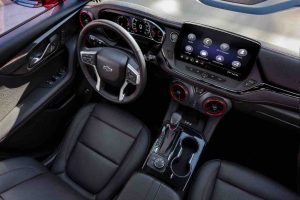
The 3LT trim – with the same 2.0 liter four cylinder engine that’s standard in the 2LT – stickers for $39,000 with front-wheel-drive and $41,700 with AWD. This model is also eligible for the optional 3.6 liter V6, which only adds $500 to the bottom line.
The sport-themed RS, which stickers for $42,500 to start (with FWD) and $45,400 with AWD comes standard with the V6, as well as a 20-inch wheel/tire package and unique exterior and interior trim differences.
Interestingly, the top-of-the-line Premier trim is priced the same as the RS but does not come standard with the V6. Instead, it comes standard with unique-to-this-trim chrome and silver accents.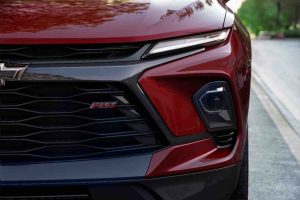
What’s New For 2023
In addition to slight styling tweaks, a larger (10 inch) LCD touchscreen in the center stack is now standard equipment in all four trims.
Wireless smartphone charging is also available in all trims.
What’s Good
Chevy doesn’t price the V6 such that only a few can afford it.
AWD isn’t mandatory with the V6 – or unavailable with the four.
Enough towing capacity (with the V6) to pull a small RV.
What’s Not So Good
Not as much cargo space as some same-sized rivals.
Max tow rating is below that of some rivals in the class, such as the Kia Telluride/Hyundai Palisade twins, which come standard with a 5,000 lb. rating and a standard V6.
Rear seat headroom (38.6 inches) is less than in rivals with higher rooflines.
No – alas – you won’t find a small-block V8 under the hood of the new Blazer.
It – like so many new vehicles, irrespective or make or model (or price, for that matter) comes standard with – wait for it! – a 2.0 liter four cylinder engine.
Just like the new Camaro!
Like almost all of them, irrespective of make/model (or price) it is turbocharged, to make up for the fact that it is a 2.0 liter four – and would otherwise be much too small (and underpowered) to adequately power a nearly two-ton (3,918 lbs. empty) vehicle like the Blazer. Turbo boost ups the power – when on boost – to 228 horsepower, which is enough power to adequately power this two ton vehicle, which gets to 60 in about 8.4 seconds.
And it gets not-bad gas mileage for a two-ton, mid-size crossover: 22 city, 29 highway. “Not bad” being defined relative to what others like it get, which is about the same.
But the Blazer is available with something more-than-adequate. A 3.6 liter V6 that makes 308 horsepower is optional. It is the same basic V6 that is available in the Chevy Camaro – and the association is deliberate. The Blazer is styled to echo the Camaro and so equipped, it can do a decent imitation of one, 0-60. That happens in just over six seconds, which is quicker than the V8-powered Z28 Camaros of the ’70s and 80s.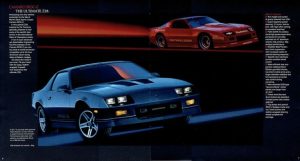
Interestingly, there’s only a slight difference in gas mileage, notwithstanding the V6 being much larger and a lot stronger. So equipped, it rates 19 city, 27 highway. It’s a negligible difference in real-world economy and it begs the question: Why not just put the V6 in every Blazer – as would have been the case ten years ago and prior, when V6 engines were always standard in vehicles of this type (and weight). Put another way, what is the advantage of putting an under-sized 2.0 liter four in a vehicle like the Blazer when there is no obvious upside to doing so – for the buyer? You get less power, not as much performance – and about the same gas mileage, after all.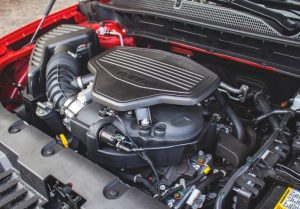
But that slight difference in miles-per-gallon per vehicle factored out over a fleet of them does have an impact upon Chevy’s Corporate Average Fuel Economy fleet average – i.e., the combined/average mileage of all the Blazers it sells. It’s enough of a difference there to affect to result and trigger fines for “non-compliance” with the arbitrary standard – currently about 35 MPG – that a car company must then pass along to the buyer in the form of a higher sticker price, making the vehicle in question less competitive in the marketplace. This arbitrary government-decreed standard is set to go up to about 50 MPG before the decade is out – and that will put paid to not just V6 engines but most engines, period.
Including even 2.0 liter engines.
The idea here being to “nudge” engines off the market entirely – in favor of electric motors. Or at least, engines with motors – i.e., hybrid-electric drivetrains. So if you want a V6 instead, this is one of your last chances to buy one.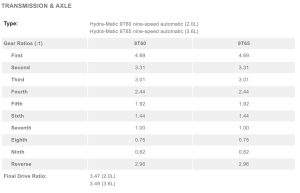
Both engines are paired with a conventional (geared) nine-speed automatic transmission rather than a CVT automatic – the latter rapidly replacing geared automatics for the same reason that 2.0 turbo fours are replacing V6s. There is little benefit to the buyer but the manufacturer ekes out a slight MPG gain by using a CVT rather than a geared automatic . . . which helps them “achieve compliance.”
Interestingly, the available AWD system is not restricted to the V6 – and you do not have to buy it, if you want the V6. This is one of the Blazer’s strongest suits in that it is not uncommon for AWD to be paired with the stronger/optional engine and often not offered with the base/less powerful engine.
Both the 2.0 and 3.6 liter engines have direct injection (DI).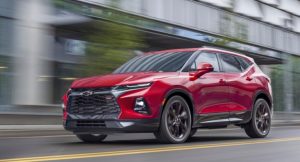
On The Road
The 2.0-powered Blazer drives like most of the rest. This isn’t bad – just boring. And even that is good, in the sense that there’s nothing unpleasant much less alarming about the way it drives. This is true pretty much across the board as far as everything that’s new, which to a great extent is mostly the same.
That business about the 2.0 engines, again.
Adequate passing power; good low-end/gets-you-going power (courtesy of the turbo’d engine having plenty of low RPM torque). More than adequate high-speed power. Even with the 2.0 engine, a Blazer easily attains and holds very illegal speeds so there is more-than-adequate power for legal and semi-legal speeds.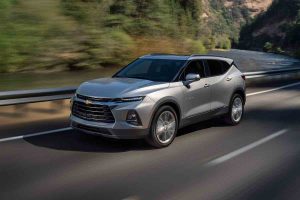
The same is true of everything – even a Prius, which can also easily attain and hold very illegal speeds.
It’s the V6 Blazer that drives differently.
And it’s not just because it has more-than-adequate power, either. It is because it has that V6, which generates sounds as well as power. A sound that is becoming less-and-less heard, for all the reasons already explained. It is also a revvy engine, because it is not turbocharged. It only makes a bit more torque – 270 ft.-lbs. vs. 258 for the 2.0 four – and it does not generate its maximum torque until it revs to 5,000 RPM. The 2.0 produces its maximum torque output at just 1,500 RPM. This latter actually makes the much smaller engine feel stronger, initially and at part throttle. But when you floor it, there’s no confusing who’s boss.
Also nice – about either configuration – is the nine speed geared automatic, which shifts up and down rather than moseys through ranges, as a CVT automatic does. It does a good job, especially of holding a lower gear when you’re driving downhill – which provides a useful engine braking effect and keeps you from having to ride the brakes to avoid building up excessive speed. 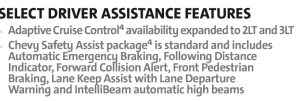
On the downside, the Blazer – all trims – come standard with what is styled the Chevy Safety Assistance Package, which might be more accurately described as the Driver Pre-emption Package. It includes such electronic annoyances as Following Distance Indicator – which pesters you if it thinks you are “following too closely” – as well as Automatic Emergency Braking and Lane Keep Assist, both of which nag you (and brake/steer for you) if the car thinks you’re not steering or braking as it is programmed to insist you ought to.
Some of these can, thankfully, be turned off. But you cannot turn them down.
Chevy stylist worked hard to try to make the Blazer look more like a four-door Camaro and less like . . . all the other crossovers out there. And it does – chiefly because of its raked/lowered roofline. This does, however, cut down some on headroom – especially for the back seat occupants – and cargo room, of which there is a bit less than in some of the others in this class.
Still, it has 30.5 cubic feet of cargo capacity behind its second row – which is more than three times as much space for cargo than a Camaro has in its purse-sized trunk (the Corvette actually has more cargo room than the Camaro) and this can be expanded to 64.2 cubic feet, which is probably plenty for most – and enough for those who are willing to trade-off a few cubic feet of capacity for the sake of not driving something that looks like everything else.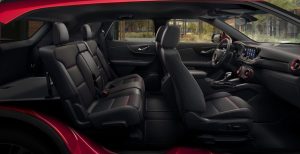
But there is another cost you may want to consider. It is the trade-off that comes with the sexier/lower roofline – and the abbreviated/tapered side glass, which results in not-so-great visibility to the sides (and rear). This is a pretty common problem generally as doors have gotten taller (and side glass narrower) which most manufacturers have resorted to as a way to improve their side-impact crash testing scores, metal being sturdier than glass. Of course, you are probably more likely to have a side-impact accident if you can’t see what’s coming at you from the sides.
Inside, there are also Camaro-ish touches, such as the extra-big ball-type vents (accented with trim rings in the RS) and inward-canted door panels. The offset (toward the driver) gear selector is a sporty touch as well.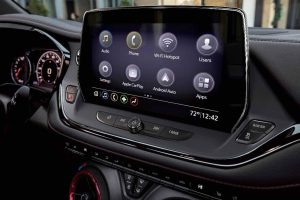
If you don’t want a powered liftgate – these often seem to take forever to open and close – you can skip it as this feature is not standard with the base 2LT trim. But you can also order it, if you’d like to have it – without stepping up to the more expensive 3LT (and higher) trims. You can also order the base 2LT trim with heated seats and adaptive cruise control, which are bundled as part of a Convenience Package that also includes wireless phone charging and a roof rack.
The RS trim mostly looks sportier – though it does come with a larger (20 inch) wheel/tire package that gives it a firmer ride and sharper steering feel. This trim also comes standard with a heated steering wheel, ambient interior lighting and an upgraded Bose stereo with eight speakers.
The Rest
You may have noticed that new cars have gotten a lot more expensive all of a sudden – and the Blazer is no exception. The ’23 model’s price is up about $1,400 vs. last year, even though the ’23 is more-or-less-the same as it was before. In normal times, there is typically a year-to-year increase of a few hundred bucks. But these times are not normal because the diminished buying power of the currency we’re obliged to use as the medium of exchange. A dollar today buys 8-12 percent less than it did a couple of years ago and that means it takes more dollars to buy more-or-less the same Blazer.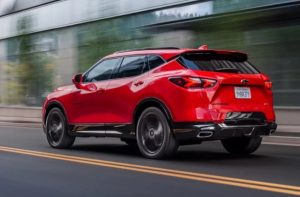
On the upside, the Blazer’s price hasn’t gone up by $3,000-$8,000 or more as has happened to many electric vehicles, including the Ford Mach e and F-150 Lightning.
The Bottom Line
You may remember the old commercial about how you could have had a V8 (as in vegetable juice). This is likely one of your last chances to get a V6.
. . .
If you like what you’ve found here please consider supporting EPautos.
We depend on you to keep the wheels turning!
Our donate button is here.
If you prefer not to use PayPal, our mailing address is:
EPautos
721 Hummingbird Lane SE
Copper Hill, VA 24079
PS: Get an EPautos magnet or sticker or coaster in return for a $20 or more one-time donation or a $10 or more monthly recurring donation. (Please be sure to tell us you want a magnet or sticker or coaster – and also, provide an address, so we know where to mail the thing!)
My eBook about car buying (new and used) is also available for your favorite price – free! Click here. If that fails, email me at EPeters952@yahoo.com and I will send you a copy directly!





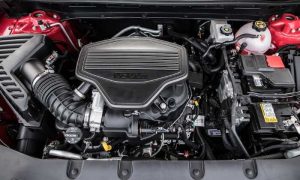
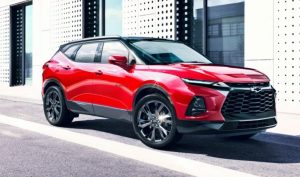








At the rate the auto manufacturers are going, they will eventually go full “Soviet Retro” with the “guidance” of the Fed. A new Trabant for everyone. Of course you will have your choice of the nameplate (Ford,GM,Dodge,etc.) on the grill.
not sure what this is but it’s not a blazer
“On the upside, the Blazer’s price hasn’t gone up by $3,000-$8,000 or more as has happened to many electric vehicles, including the Ford Mach e and F-150 Lightning”
Faint praise for the Blazer. I priced my Blazer at the Chevy site and it came up at around $47,000. WTF who the Phuck is getting all this money. Hint, it ain’t me. Why don’t we find out the salaries of some of these GM workers staring with the chief and the floor sweeper and then we’ll find out why my Phukin Blazer costs $47,000.
Doesn’t sound like this one is going to be a big hit.
A few jurisdictions will buy Blazers as cop cars. So in the unlikely event you ever see one, slow down. 🙂
I drove my Blazer today, to work on a wood scrounge half a mile away. There’s one more load there if I want it enough (twin trunk tree, the remaining wood will have to be noodled to be usable as firewood).
It is a 1977, carolina blue, dented and beat up truck that rides high and sounds mean (but looks pretty, I mean come on, these old trucks got kind faces to them). I get 10 miles to the gallon ethanol free and I don’t have a touchscreen. I understand why the company uses the same name, they are like Hollywood, which has no new ideas so just bastardizes the old ones from more honest times, to milk them for all of their precious fluids.
I’ll keep driving old stuff until my time is up, God willing. Their steady work toward banning the ICE has turbocharged my wood-scrounging bent.
They should have called it Equinox Sport or something. This vehicle, while it may be a good one, has no business having the Blazer name on it.
Bubble cars suck.
‘Once upon a time, Chevy’s Blazer was a full-size 4×4.’ — eric
‘Blazer’ has an explicit meaning to anyone even moderately acquainted with trucks: namely, the K5 Blazer made from 1969-1994, which I still encounter often.
Slapping a Blazer badge on a nondescript crossover blurs and destroys brand equity. It’s the same error Ford has made by applying its iconic Mustang brand to an EeeVeeee.
Half a century ago, Chevrolet Impala was the archetypal American car, ingrained into the culture. Does it even exist today? I couldn’t tell you.
GM and Ford have morphed into something resembling an electric utility or a telco: hidebound bureaucracies, run by not-very-bright people with no vision. How hard is it to make up a new model name, for Dog’s sake, instead of borrowing an incongruous old one? (That’s a rhetorical question for EeeVeeee Mary.)
US auto makers have reached their expiration date. GM gawks at the incoming giant meteor, as Ford watches in bafflement:
https://ibb.co/f81MLWC
Coming soon! 7th Gen “Camaro”*
Is it a Muscle Car? NO!
Is it a sports car? Naw
It is even a car? Nope, it’s a Crossover
What engine does it have, definitely an V8 right? Naw, it’s electric.
It’ll be like that turd on wheels, the Mach-e, a posers car with a pony on the front. Coming soon from Government Motors, where we care about everything but cars